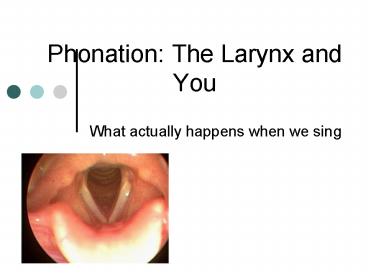Phonation: The Larynx and You - PowerPoint PPT Presentation
1 / 10
Title:
Phonation: The Larynx and You
Description:
The lungs and diaphragm contract, pushed air to flow into the glottis ... Chiaroscuro- Light and dark properties, brilliance plus warmth and richness ... – PowerPoint PPT presentation
Number of Views:592
Avg rating:3.0/5.0
Title: Phonation: The Larynx and You
1
Phonation The Larynx and You
- What actually happens when we sing
2
Science! The Myoelastic-Aerodynamic Theory
- Simpler terms How the muscles in the larynx and
air interact to create sound. - Three things need to happen to phonate, or create
sound - The lungs and diaphragm contract, pushed air to
flow into the glottis - Muscles in the larynx cause the vocal fold to
adduct, or close - Airflow through the glottis cause the folds to
vibrate
3
More Science The Bernoulli Effect
- When the glottis is closed, air pressure builds
up - When it reaches a certain point, it forces the
vocal folds open - As the air rushes out, the vocal folds are sucked
back together - The cycle starts again.
4
Locating stuff in the larynx how to describe
where things are
- Anterior/posterior- Front/back
- Superior/inferior- above/below
- Medial- Middle
- Lateral- towards the outside
- Bilateral- on both sides
- Unilateral- on one side
- Intrinsic- Inside
- Extrinsic- Outside
5
The Framework of the larynx The extrinsic
structures
6
The Framework of the larynx The intrinsic
structures
7
The muscles of the Larynx
8
The Vocal Tone What causes the voice to sound
like it does
- Types of phonation
- Aspirate- A breathy tone. Caused by incomplete
closure of the vocal cords, which allows air to
escape - Pressed- A tight sound. Caused by the vocal cords
colliding too hard - Coordinated- The ideal sound. The right balanced
of airflow and closure of the cords allow for the
most efficient sound.
9
Onset and release Starting and stopping the sound
- Both can be described in the following ways
- Aspirate- Breathy. Again the vocal cords dont
close enough - Glottal onset- The vocal cords are pressed
together, and then are forced open when the air
pressure builds up - Glottal release- A grunt occurs when the vocal
cords are forced close - Coordinated- Ideal combination of airflow and
closure of the vocal cords
10
So what does a good voice sound like?
- Sounds natural for the person singing
- No tension in the face, neck, limbs, and torso
- Tonal clarity and accuracy
- Ability to swing from various dynamic levels with
ease - Natural, unforced vibrato (6-8 pulses/second)
- Chiaroscuro- Light and dark properties,
brilliance plus warmth and richness - A ringing, forward in the mask focus

